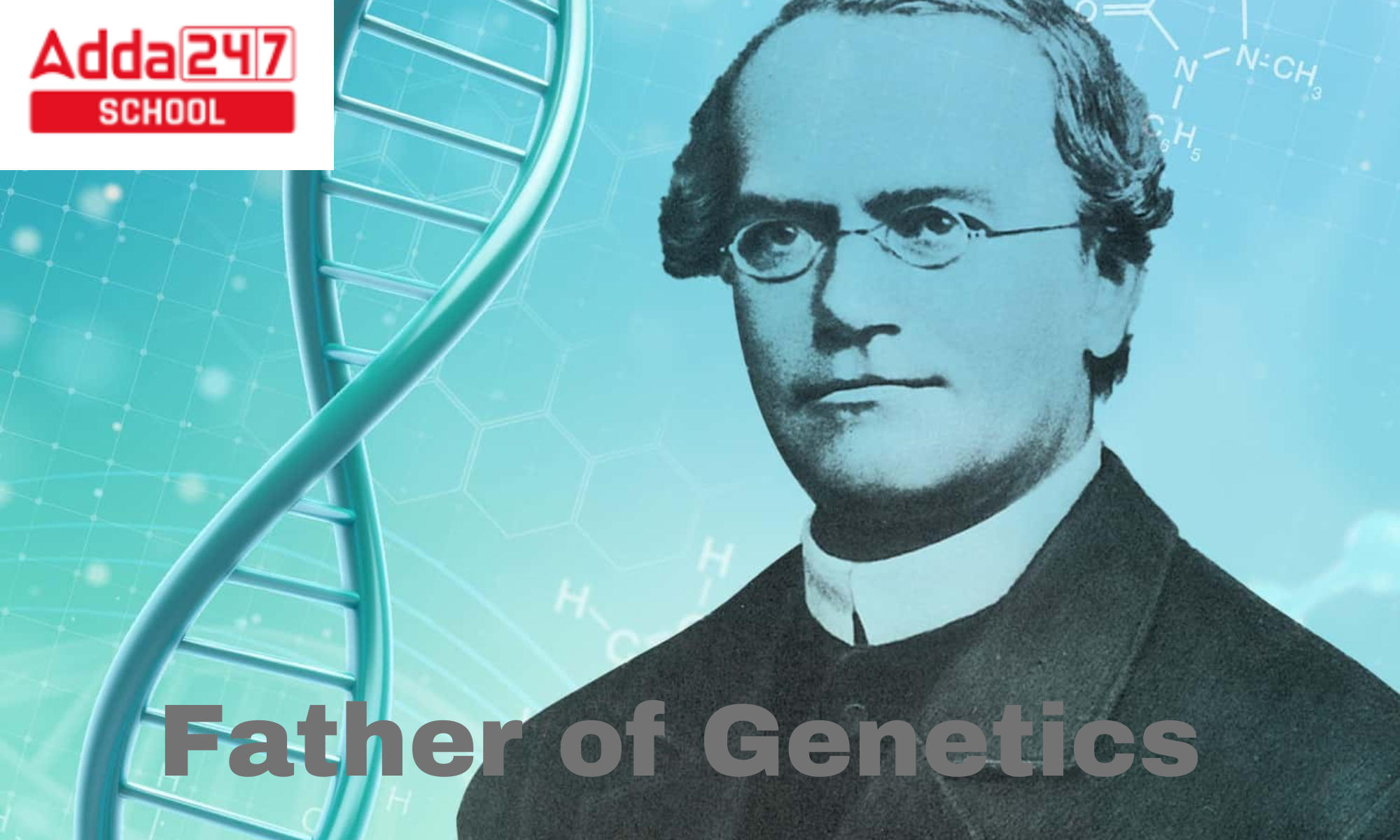Father of Genetics
Gregor Johann Mendel, or Gregor Mendel, who is known as the father of Genetics
Who is the father of genetics?
Gregor Johann Mendel, or simply Gregor Mendel, who is known as the father of Genetics was an Augustinian friar and the abbot of St. Thomas’ Abbey in Brunn (Brno), Margraviate of Moravia. He was also a biologist, meteorologist, mathematician, and Augustinian. Gregor Mendel received posthumous recognition as the father of the modern science of genetics or father of Genetics. Gregor Mendel was born into a German-speaking family in the Silesian region of the Austrian Empire. Despite the fact that farmers had known for thousands of years that crossbreeding could favour certain desirable traits in both animals and plants, Gregor Mendel’s pea plant experiments carried out between 1856 and 1863 established many of the laws of heredity, now known as the laws of Mendelian inheritance.
Father of Genetics Full Name
The Full name of the Father of Genetics is Gregor Johann Mendel.
Father of Genetics- Gregor Mendel Life and Career
At the border of Moravia and Silesia in Austrian Empire’s Heinzendorf bei Odrau, Gregor Mendel was born into a German-speaking household. He was the son of Anton and Rosine Mendel, and he had two sisters: Theresia, who was younger, and Veronika, who was older.
Plant height, pod shape and colour, seed shape and colour, blossom location and color—these are the seven pea plant traits that Gregor Mendel studied. Gregor Mendel demonstrated, for instance, that cross-breeding a true-breeding yellow pea with a true-breeding green pea resulted in offspring that always produced yellow seeds. However, the green peas returned in the following generation at a ratio of 1 green to 3 yellow. Gregor Mendel developed the phrases “recessive” and “dominant” in connection to particular features to describe this phenomena. In the previous illustration, the yellow trait is dominant and the green trait, which appears to have disappeared in the first filial generation, is recessive.
Gregor Mendel’s findings, which are now known as genes, show how invisible “factors” function to reliably determine an organism’s features, and were published in 1866.
Father of Genetics- What are Genetics in Biology?
The study of genes and heredity, or how particular characteristics or traits are passed from parents to offspring as a result of changes in DNA sequence, is known as genetics. A gene is a section of DNA that has the instructions needed to create one or more molecules that support bodily function. A double helix, or corkscrew-shaped ladder, is how DNA is shaped. The bases are pairs of the four building blocks adenine, thymine, guanine, and cytosine, and the two ladder rails are referred to as the backbones. The instructions for constructing molecules, the majority of which are proteins, are included in the sequences of these nucleotides. The number of genes in humans is thought to be around 20,000.
Father of Genetics in India
Popularly known as Father of Genetics in India, Lalji Singh FNA, FASc, an Indian scientist, was the “Father of Indian DNA Fingerprinting” and worked in the field of DNA fingerprinting technology in India (5 July 1947–10 December 2017). Singh also researched in the fields of human migration and evolution, forensics in wildlife conservation, and the molecular basis of sex determination. In appreciation of his contribution to Indian science and technology, he was awarded the Padma Shri in 2004.
Father of Modern Genetics in Engineering
Paul Berg began genetic engineering in 1972. He was able to introduce the SV-40 viral gene into the bacteria using the lambda phage. Another moniker for Berg is “Father of Genetic Engineering.” He received the 1980 Nobel Peace Prize.
Other names for genetic engineering include genetic alteration and genetic manipulation. That is a straightforward biotechnological change of an organism’s genes. It is a collection of technologies used to change the genetic makeup of cells, including the movement of genes within and between species to produce better or entirely new organisms.
By employing recombinant DNA techniques to separate and clone the relevant genetic material, or by synthesising DNA chemically, new DNA can be created.
Father of Genetics in Hindi
अनुवांशिकी के जनक कौन है ?
ग्रेगर जोहान मेंडेल, या बस ग्रेगर मेंडल, जो जेनेटिक्स के पिता के रूप में जाने जाते हैं, एक ऑगस्टिनियन तपस्वी थे और सेंट थॉमस एब्बी इन ब्रून (ब्रनो), मोराविया के मार्गावेट के मठाधीश थे। वह एक जीवविज्ञानी, मौसम विज्ञानी, गणितज्ञ और ऑगस्टिनियन भी थे। ग्रेगर मेंडल को मरणोपरांत आनुवंशिकी के आधुनिक विज्ञान के जनक या आनुवंशिकी के जनक के रूप में मान्यता मिली। ग्रेगर मेंडल का जन्म ऑस्ट्रियाई साम्राज्य के सिलेसियन क्षेत्र में एक जर्मन-भाषी परिवार में हुआ था। इस तथ्य के बावजूद कि किसान हजारों वर्षों से जानते थे कि क्रॉसब्रीडिंग जानवरों और पौधों दोनों में कुछ वांछनीय गुणों का पक्ष ले सकती है, 1856 और 1863 के बीच किए गए ग्रेगर मेंडल के मटर के पौधे के प्रयोगों ने आनुवंशिकता के कई कानूनों को स्थापित किया, जिन्हें अब मेंडेलियन के कानूनों के रूप में जाना जाता है। विरासत।
आनुवंशिकी के जनक का पूरा नाम
आनुवंशिकी के जनक का पूरा नाम ग्रेगोर जोहान मेंडेल या केवल ग्रेगोर मेंडल है।
आनुवंशिकी के जनक- ग्रेगोर मेंडल जीवन और कैरियर
ऑस्ट्रियन साम्राज्य के हेंजेंडॉर्फ बीई ओड्राउ में मोराविया और सिलेसिया की सीमा पर, ग्रेगोर मेंडेल का जन्म जर्मन भाषी परिवार में हुआ था। वह एंटोन और रोजिन मेंडल का बेटा था, और उसकी दो बहनें थीं: थेरेसिया, जो छोटी थी और वेरोनिका, जो बड़ी थी।
पौधे की ऊँचाई, फली का आकार और रंग, बीज का आकार और रंग, बौर का स्थान और रंग – ये मटर के पौधे के सात लक्षण हैं जिनका अध्ययन ग्रेगोर मेंडल ने किया था। उदाहरण के लिए, ग्रेगर मेंडल ने प्रदर्शित किया, कि सच्चे-प्रजनन वाले पीले मटर को सच्चे-प्रजनन वाले हरे मटर के साथ क्रॉस-ब्रीडिंग करने से संतान पैदा होती है जो हमेशा पीले बीज पैदा करती है। हालांकि, अगली पीढ़ी में हरी मटर 1 हरी से 3 पीली के अनुपात में वापस आ गई। ग्रेगर मेंडल ने इस घटना का वर्णन करने के लिए विशेष सुविधाओं के संबंध में “आवर्ती” और “प्रमुख” वाक्यांश विकसित किए। पिछले दृष्टांत में, पीला लक्षण प्रमुख है और हरा गुण, जो पहली संतानीय पीढ़ी में गायब हो गया प्रतीत होता है, अप्रभावी है।
ग्रेगोर मेंडेल के निष्कर्ष, जो अब जीन के रूप में जाने जाते हैं, दिखाते हैं कि कैसे अदृश्य “कारक” एक जीव की विशेषताओं को मज़बूती से निर्धारित करने के लिए कार्य करते हैं, और 1866 में प्रकाशित हुए थे।









 [Live Updates] NTA CUET Undergraduate Re...
[Live Updates] NTA CUET Undergraduate Re...
 IGNTU CUET Cutoff 2025, Check Category W...
IGNTU CUET Cutoff 2025, Check Category W...
 CGBSE Revaluation Result 2025 Announced ...
CGBSE Revaluation Result 2025 Announced ...









